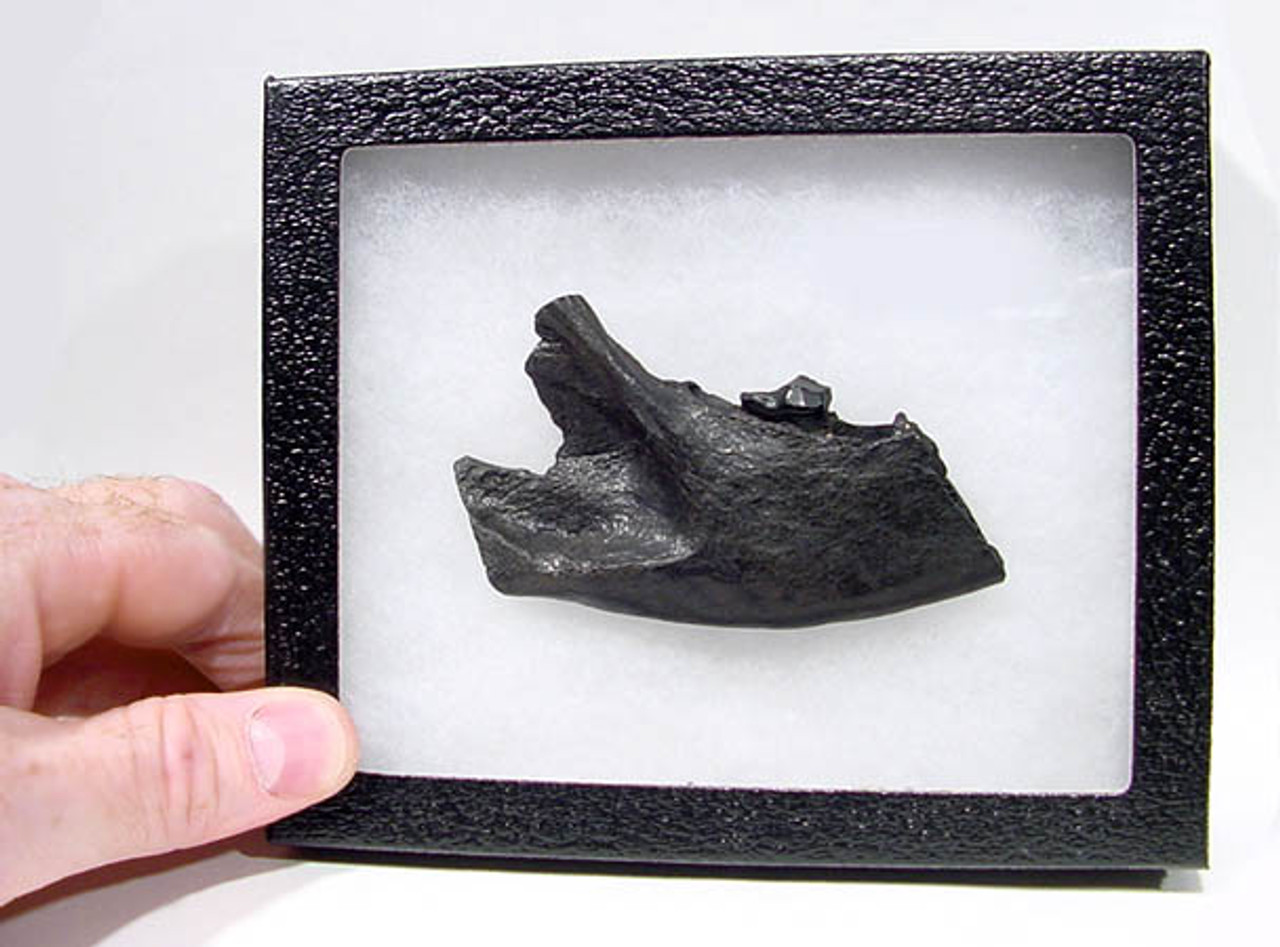Product Description
ID
|
Amphicyon longiramus
|
||
FOUND
|
Suwannee River - Florida, U.S.A.
|
||
AGE
|
EARLY MIOCENE: 20 - 18 million years ago
|
||
SIZE
|
3.75" long
|
||
CONDITION
|
NO REPAIR OR RESTORATION
|
||
NOTE
|
TERRESTRIAL VERTEBRATE FOSSILS FROM
|
||
INCLUDES DISPLAY BOX - Actual Item - One Only
Comes with a certificate of authenticity / information sheet |
|||
CLICK HERE TO LEARN MORE ABOUT BEAR-DOGS
The bizarre fauna of prehistoric Florida is nothing short of fascinating. Amongst every type of animal that ever walked this part of the planet millions of years ago, fossil remains of this horrific and ferocious beast ranks as one of the rarest as its entire family lineage emerged and then went completely extinct during the Miocene Period. This EXTREMELY valuable specimen dates back to the ARIKAREEAN AGE, a term used in the scientific community as part of the North American Land Mammal Ages (NALMA). These ages represent periods on the geologic time scale as they relate to this type of fauna.
Of all the fossils we will ever offer, this specimen will always rank as one of the rarest based on known remains and scientific evidence of Florida's fossil record for this creature. This is a right anterior mandible of the giant bone-crushing bear-dog Amphicyon longiramus. In the Early Miocene of Florida, no animal was more deadly. This mammal was the apex predator of its time and had no equal. Never before have we been fortunate to offer ANY fossil from this rare and little known about beast. It is likely you will never see anyone offer specimens of this animal!
The entire bone of this specimen is completely fossilized and heavy as stone. The color throughout the bone and tooth is pure jet black giving the fossil a sinister and evil appearance - fitting for such a deadly predator. One intact bone-crushing molar is still embedded to the jawbone and is original as found. It appears broken but it is not. The chewing surface is well-worn from feeding when the beast was alive and indicates this specimen came from an old, full-grown animal with years of killing and bone-crushing experience! Surfaces of the tooth and bone are nothing short of spectacular and color and sheen are natural! NO REPAIR and NO RESTORATION. For the fossil of a lifetime in rarity and display appeal, this is definitely a top recommendation of ours!
TERRESTRIAL VERTEBRATE FOSSILS FROM THE EARLY MIOCENE OF FLORIDA ARE SUPER RARE AND ONLY FOUND AT A HANDFUL OF SITES - EXOTIC AND VERY HIGHLY RECOMMENDED!
THIS BEAST WAS THE APEX PREDATOR OF FLORIDA IN THE EARLY MIOCENE AND HAD NO EQUAL
INFINITELY MORE RARE THAN COMPARABLE DIRE WOLF REMAINS OFFERED AT A MUCH LESSER PRICE THAN THE RARITY OF THIS SPECIMEN REFLECTS!
Made famous in the BBC digital television presentation "Walking with Prehistoric Beasts", the bear-dogs were ferocious carnivores that ranged from the size of a medium dog to the size of a bear. These predators known as Amphicyonids were neither dogs nor bears but were more closely related to bears. They emerged and subsequently went extinct during the Miocene, once inhabiting regions of Eurasia and North America.
Amphicyonidae were a diverse group with species resembling all or part of modern dogs, hyenas and bears. Leaner built species had cheek teeth designed for shearing meat whereas the stouter and larger species had teeth designed to crush bone. Males were larger than females. They lived in dens and had the ability to dig large burrows.
Amphicyon longiramus was the largest of the Florida species at the size of a full-grown bear. This species evolved in Eurasia and migrated to North America. A. longiramus was the top predatory land mammal of its time in Florida during the Early Miocene. Its skull was long in comparison to its body size but brain size was lacking. Its posture and structure were similar to a bear and it is theorized that it must have hunted using ambush techniques that are used today by modern grizzlies. Most likely, this giant bear-dog burst upon its unfortunate victim at close range and dealt its prey a single deadly blow with its massive forepaw. This theory of attack is also based on its relative the bear as it was incapable of sustaining long runs in pursuit of prey. Compared to lighter species of Amphicyonids, Amphicyon longiramus had heavy posterior dentition allowing it to crush bone in its jaws.
 US DOLLAR
US DOLLAR
 EURO
EURO
 AUSTRALIAN DOLLAR
AUSTRALIAN DOLLAR
 CANADIAN DOLLAR
CANADIAN DOLLAR
 POUND STERLING
POUND STERLING




















